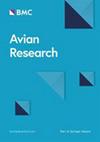Step-by-step to success: Multi-stage learning driven robust audiovisual fusion network for fine-grained bird species classification
IF 1.7
2区 生物学
Q1 ORNITHOLOGY
引用次数: 0
Abstract
Bird monitoring and protection are essential for maintaining biodiversity, and fine-grained bird classification has become a key focus in this field. Audio-visual modalities provide critical cues for this task, but robust feature extraction and efficient fusion remain major challenges. We introduce a multi-stage fine-grained audiovisual fusion network (MSFG-AVFNet) for fine-grained bird species classification, which addresses these challenges through two key components: (1) the audiovisual feature extraction module, which adopts a multi-stage fine-tuning strategy to provide high-quality unimodal features, laying a solid foundation for modality fusion; (2) the audiovisual feature fusion module, which combines a max pooling aggregation strategy with a novel audiovisual loss function to achieve effective and robust feature fusion. Experiments were conducted on the self-built AVB81 and the publicly available SSW60 datasets, which contain data from 81 and 60 bird species, respectively. Comprehensive experiments demonstrate that our approach achieves notable performance gains, outperforming existing state-of-the-art methods. These results highlight its effectiveness in leveraging audiovisual modalities for fine-grained bird classification and its potential to support ecological monitoring and biodiversity research.
一步一步走向成功:多阶段学习驱动的鲁棒视听融合网络用于细粒度鸟类物种分类
鸟类的监测和保护是维持生物多样性的必要条件,而细粒度的鸟类分类已成为这一领域的重点。视听模式为这项任务提供了关键线索,但强大的特征提取和有效的融合仍然是主要挑战。本文提出了一种用于细粒度鸟类物种分类的多阶段细粒度视听融合网络(msgf - avfnet),该网络通过两个关键组成部分解决了这些挑战:(1)视听特征提取模块,该模块采用多阶段微调策略提供高质量的单峰特征,为模态融合奠定了坚实的基础;(2)视听特征融合模块,将最大池化聚合策略与新颖的视听损失函数相结合,实现有效、鲁棒的特征融合。实验在自建的AVB81和公开的SSW60数据集上进行,分别包含81种和60种鸟类的数据。综合实验表明,我们的方法取得了显著的性能提升,优于现有的最先进的方法。这些结果突出了该方法在利用视听方式进行细粒度鸟类分类方面的有效性,以及它在支持生态监测和生物多样性研究方面的潜力。
本文章由计算机程序翻译,如有差异,请以英文原文为准。
求助全文
约1分钟内获得全文
求助全文
来源期刊

Avian Research
ORNITHOLOGY-
CiteScore
2.90
自引率
16.70%
发文量
456
审稿时长
46 days
期刊介绍:
Avian Research is an open access, peer-reviewed journal publishing high quality research and review articles on all aspects of ornithology from all over the world. It aims to report the latest and most significant progress in ornithology and to encourage exchange of ideas among international ornithologists. As an open access journal, Avian Research provides a unique opportunity to publish high quality contents that will be internationally accessible to any reader at no cost.
 求助内容:
求助内容: 应助结果提醒方式:
应助结果提醒方式:


